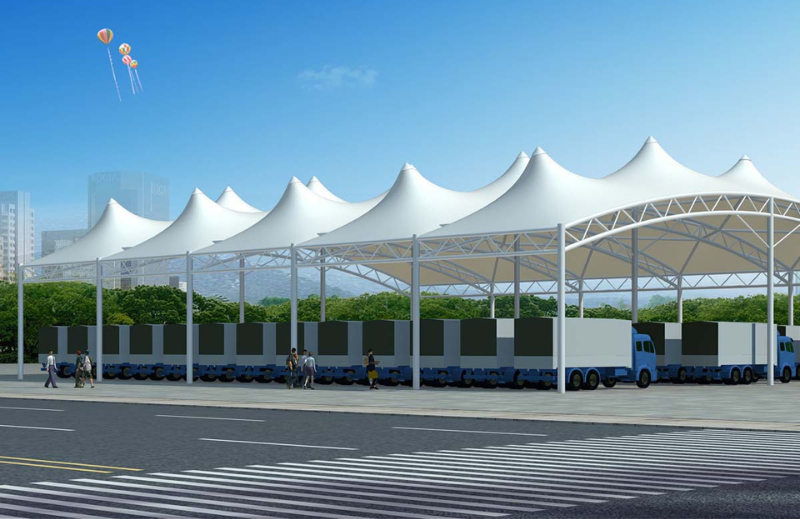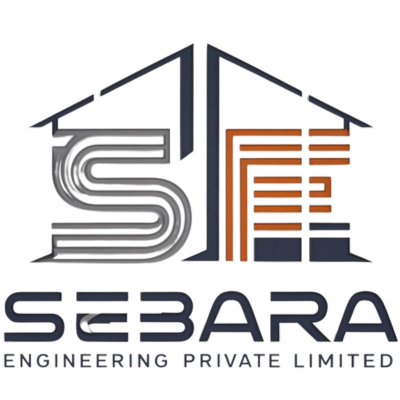Tensile Fabric Structures
- Home
- Tensile Fabric Structures

Tensile Fabric Structures are innovative architectural solutions that use tensioned fabric materials to create lightweight, flexible, and aesthetically striking structures. They are commonly used for a variety of applications, including sports arenas, exhibition halls, outdoor canopies, event pavilions, and shade structures. The combination of architectural appeal, strength, and versatility makes tensile structures an ideal choice for both temporary and permanent installations.
Key Features of Tensile Fabric Structures
1. Lightweight Yet Strong
o Tensile fabric structures use materials such as PTFE (Polytetrafluoroethylene), PVC-coated polyester, or ETFE (Ethylene Tetrafluoroethylene), which are lightweight but have high tensile strength.
o These materials allow the structures to span large areas without heavy supports, making them ideal for open spaces and areas where minimal obstruction is desired.
2. Aesthetic Appeal
o The fluid and dynamic forms achievable with tensile fabric create visually stunning and iconic architectural designs.
o They offer flexibility in shape and design, including cone-shaped, wave-like, and sail forms, making them suitable for enhancing the architectural character of any space.
3. Durability and Weather Resistance
o Modern tensile fabrics are designed to withstand extreme weather conditions, including heavy rain, strong winds, snow loads, and UV exposure.
o These materials are often treated with special coatings to resist tearing, mold growth, and fading, ensuring long-lasting performance and minimal maintenance.
4. Quick Installation and Cost Efficiency
o Tensile fabric structures are quicker to install than traditional buildings, as the fabric and frame are pre-fabricated off-site and assembled on location.
o The efficient use of materials and reduced need for heavy structural components contribute to lower construction and installation costs.
o They are also an energy-efficient solution, as they can incorporate natural lighting and ventilation.
5. Flexibility and Modular Design
o Tensile structures can be designed as modular systems, allowing for easy expansion, relocation, or temporary setup.
o The modular nature makes them ideal for events, exhibitions, and spaces where flexibility is a priority.
Applications of Tensile Fabric Structures
1. Sports Facilities and Arenas
o Tensile structures are often used to cover stadiums, sports arenas, and swimming pools, providing large, column-free spaces that allow clear visibility and unobstructed movement.
o They also provide weather protection while allowing natural light to permeate the space.
2. Exhibition Halls and Event Pavilions
o These structures are popular for events and exhibitions due to their quick installation, flexibility, and visual impact.
o They can be customized to create unique shapes and themes, enhancing the event experience for visitors.
3. Outdoor Canopies and Shade Structures
o Tensile fabric canopies are commonly used for outdoor areas like shopping malls, parks, airports, and transport hubs to provide shade and shelter while maintaining an open and airy environment.
o These structures can be designed to integrate seamlessly with existing landscapes and architecture.
4. Architectural Façades and Roof Systems
o Tensile fabrics are also used for building façades and roofs to create lightweight and energy-efficient structures.
o They can be used to cover atriums, skylights, and building extensions, allowing natural light to enter while reducing the building's energy consumption.
5. Commercial and Residential Applications
o Tensile structures are increasingly popular in commercial spaces like restaurants, cafes, and resorts for outdoor dining areas or poolside lounges.
o They provide a modern aesthetic while offering practical benefits like sun protection and weather resistance.
Advantages of Tensile Fabric Structures
· Versatility: The ability to create unique shapes and designs tailored to specific project requirements.
· Light Transmission: Many tensile fabrics allow for controlled light transmission, reducing the need for artificial lighting during the day.
· Sustainability: The use of recyclable materials and the structure's ability to optimize natural lighting and ventilation contribute to sustainable building practices.
· Durability: High-performance fabrics coated with advanced polymers ensure longevity and low maintenance.
Types of Tensile Fabric Structures
1. Tensioned Membrane Structures
o These structures are composed of fabric stretched over a framework of cables and supports to achieve tension and create stability.
o Commonly used for canopies, walkways, and roof systems, they offer flexibility in design and efficient use of materials.
2. Air-Supported Structures
o These are lightweight structures that rely on air pressure to maintain their shape. Commonly used for temporary installations like sports domes and event tents, they are easy to set up and dismantle.
o They are often paired with mechanical systems to control internal air pressure and temperature, ensuring comfort and safety.
3. Cable Net Structures
o Using a combination of cables and fabric, these structures offer high tensile strength and flexibility. They are ideal for creating large, open spaces with minimal visual obstruction.
o Examples include stadium roofs and large-span exhibition halls.
4. Frame-Supported Tensile Structures
o These structures incorporate a frame, often made of steel or aluminum, to provide support for the fabric.
o They are suitable for smaller applications like entrance canopies, awnings, and modular pavilions.
Why Choose Tensile Fabric Structures?
1. Architectural Freedom: The design flexibility allows architects to experiment with unique shapes, making tensile fabric structures a perfect fit for iconic and innovative architecture.
2. Quick and Efficient Installation: Pre-fabrication and lightweight components reduce installation time and labor costs.
3. Energy Efficiency: The ability to control sunlight and heat makes these structures energy-efficient, providing a sustainable solution for various applications.
4. Adaptability: Tensile structures can be temporary or permanent, providing solutions that can be easily modified, relocated, or expanded as needed.
Tensile fabric structures offer a perfect blend of aesthetics, functionality, and efficiency. Whether for large-scale commercial projects or smaller residential applications, they provide an adaptable and innovative approach to modern architecture.
